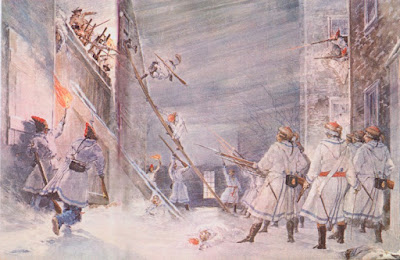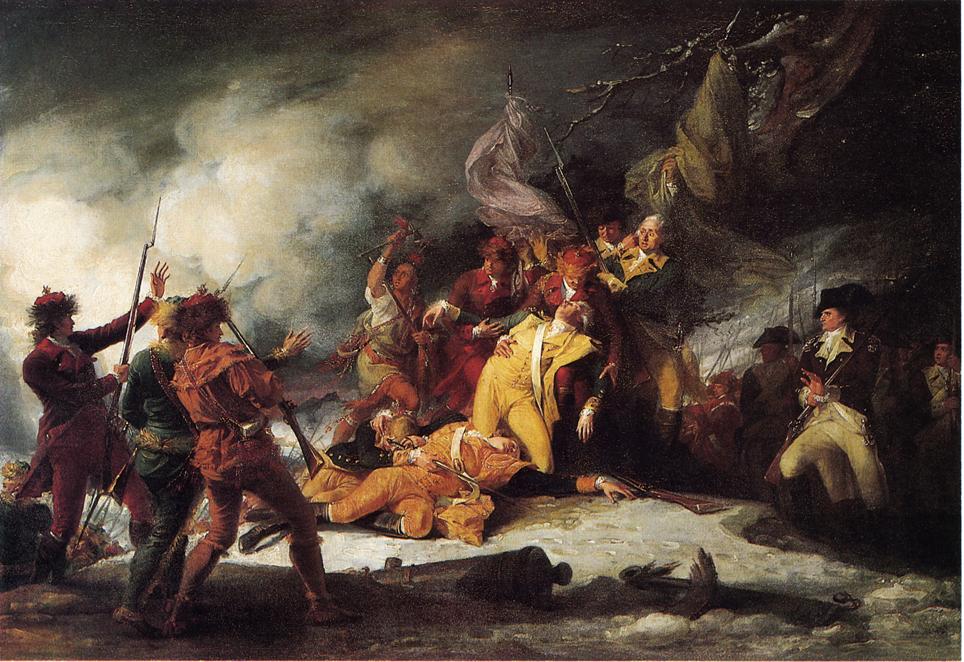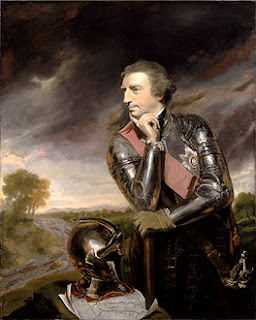 |
| "Defending Quebec from an American Attack, December 1775" The Quebec Campaign was one of Schuyler's first commands after receiving his commission. |
On September 6th,
1775, Philip Schuyler arrived outside of “St Johns” (Sainte-Jean-sur-Richelieu
– henceforth St. Jean, except in quotes), outside of Montreal. There he
encamped and prepared his troops for a thrust into St. Jean that was part of
the two pronged attack now known as the Invasion of Quebec. With Schuyler’s
predilection for espionage, he was not going to go in blind, and sought
information; he wished, of course, to know the size and condition of the British military
at St. Jean, but also hoped to find Canadians sympathetic to the
American cause. Within the day, Philip Schuyler received that information
without even seeking it out. As he wrote to George Washington:
“In
the Evening a Gentleman Mr [word mutilated by Washington] whose
Name I can only mention to Your Excellency, not having even ventured it to the
Congress & therefore beg You to eraze the Scored Part of the Letter after
Perusal came to me & gave
me the following account,” September 20th 1775
Who was this mysterious gentleman? Why might not Schuyler
have been keen to share his source with Congress? And what was the source’s
motivation for bringing Schuyler information? The answers tell the story of a sometimes
dark, opportunistic and intriguing character in the American Revolution.
Through later records, the name scratched out by Washington per Schuyler's instruction in this letter
is identified as Moses Hazen, a former British soldier who had fought in the
French and Indian War and purchased property and retired in St. Jean just
before the outbreak of the Revolution. He was only a few month older than
Schuyler and joined the military within a year of Schuyler’s commission. The two men’s French and Indian War career paths began
similarly and gave them a number of opportunities to have met prior to this
night in 1775. Schuyler had a handful of operatives available in the Montreal
area, so the fact that he trusted Hazen’s intel rather than, or in addition to, seeking out other sources may have been indicative of a previous connection
that led Schuyler to trust him.
It is likely that Hazen was the same “Canadian,who twelve days ago left St Johns” who Schuyler collected information from earlier that year, just
after his arrival at Fort Ticonderoga. That letter of July 18th echoes that of September 20th in another way – Schuyler warns
Washington “this, my dear General, as well as what follows in this
paragraph I pray may be entre nous [between us] for reasons I need not suggest”.
The fact that Schuyler was hesitant to bandy the name Hazen
about Congress may be further evidence that Schuyler was at least familiar with
Hazen’s reputation – Hazen’s military past was, at best, morally ambiguous.
affair has sullied his merit with me” – this is the same
General Amherst who ordered blankets from smallpox wards to be sent among
the Native tribes. Before settling down in St. Jean, Hazen was also
accused of involvement in the scalping of a priest and thirty parishioners, and
of having an affair with the wife of one Joseph Kelly. Kelly further claimed
that Hazen had him imprisoned with a false charge to avoid the issue of the
affair. To top off his apparent untrustworthiness, Hazen had also reported on the first skirmishes of the Revolution to British General Carleton
during the early months of 1775 and had been authorized to form a British unit,
though he declined to do so.
We do not know if Schuyler was aware of these actions, but either
based on a previous association with Hazen, or some other instinct, Schuyler
chose to trust Hazen’s military intelligence and passed the following
information to Washington:
“That
there were then at St Johns about 100 Indians & that there was a considerable
Body with Colo: Johnson; That the Fortifications were compleat [sic] &
strong & plentifully furnished with Cannon; […] That he does not believe
that our Army will be joined by one Canadian; […] That in the Situation we were
in he judged it would be imprudent to attack St Johns and advised Us to send
some Parties amongst the Inhabitants & the Remainder of the Army to retire
to the Isle-au-Noix, from whence we might have an Intercourse with La Praire”
This bleak report was a blow to Schuyler, who had been hopeful
that his surge into Canada would be met with enthusiasm from Canadians.
He had believed that militias from St. Jean, sympathetic to the Revolutionary
cause, would join him for the push into Montreal and through to Quebec and that
the Natives would remain neutral. This information may have been particularly
disheartening in contrast to the letter of July 18th. If “A Canadian, who twelve days ago left St Johns” was
in fact Hazen, he had ensured Philip “that there
are many Indians in Canada, but believes neither they or the Canadians will
join [the British forces]”.
Schuyler’s hope was further dampened by illness sweeping the
army. He reports that the troops “returned on
Monday the Eleventh, on Tuesday the twelfth I found I had upwards of 600 sick,
Waterbery’s Regiment being reduced to less than 500” and that he had fallen ill
as well.
All of this in concert led Schuyler
to fall back to Ile-aux-Noix, just as Hazen had suggested, to reconsider the
attack on St. Jean.
But reports from James
Livingston said that he was successful in raising troops near Chambly (eventually
the 1st Canadian Regiment under Livingston's command) and in transporting cannons
within range of St. Jean where he reported much more favorable odds for the
Continental Army - making it sound like Hazen’s intel was either incorrect or
exaggerated. The attack would go forward on September 17th, by which
point Schuyler had turned over command to General Montgomery in order to deal
with an attack of gout.
In the meantime, Moses Hazen
had returned to his home in St. Jean. The series of events that followed lead
us to question what his true motivation was for the news delivered to Philip
Schuyler at the eve of the siege of St. Jean. Was Hazen presenting accurate
information or slanting the facts in hopes that the battle would circumnavigate
St. Jean? Was he hesitant to come out of retirement or undecided on what side
to come out of retirement for? Was his primary concern just the preservation of
his home and property value?
During the attack on the 17th, John Brown, a spy
who had also been reporting back to Schuyler, came in contact with Hazen during
a skirmish north of the Fort and arrested him. It is unclear if Hazen participated
in the skirmish in any way or was just arrested because his loyalties were unknown. He was held only briefly by
the Americans before Brown’s men were attacked and Hazen was abandon to the
British, who arrested him in turn. In the meantime, General Mongomery informs Schuyler that “Mr
Livingston some Days ago took Post at Hazen’s House with near 200 Canadians,
they are erecting a Battery there, which seems to make the Garrison very uneasy”.
Given the quick turnover, it is possible that Hazen did not even know that the
Continental Army had set up their base of operations on his estate just across
from the Fort in St. Jean.
Hazen would not return to his home for some time as he was
instead sent to Montreal where he was imprisoned under General Carleton for
nearly two months. As the Continental Army pushed through St. Jean into
Montreal, Hazen was once again abandoned in transfer. According to the
Dictionary of Canadian Biography, Hazen claimed that Carleton had again offered
him a command under the British, but he once again refused on his loyalties to
the American cause. He claimed that the unpleasant conditions of his
imprisonment further solidified his loyalty and he officially joined the American
army during their attack on Quebec.
 |
| Hazen was present for the Death of General Montgomery during the siege of Quebec in 1775 and was sent to Congress to report on the battle. |
Somewhat strangely, less than two months after joining the
American cause, Hazen was sent as an envoy, alongside the decade younger Edward
Antill to report to Congress on the death of General Montgomery and the course of
the Quebec campaign. In asking Congress to send reinforcements, Hazen
negotiated that one of the two Canadian units formed, would be under his own
command. The 1st Canadian Regiment was promised to James Livingston
by General Montgomery, while the 2nd Canadian Regiment was intended
(by Benedict Arnold, who led the second arm of attack during the Quebec
campaign) to be given to John Duggan. In addition to usurping Duggan’s
commission, Hazen negotiated monies owed to him for the use and damaging of his
property and an agreement regarding the future treatment of his property in St.
Jean for the remainder of the war. He, rather ridiculously, valued the property
damages upwards of $11,000, though Congress was only willing to pay him about
20% of that.
 |
| Benedict Arnold had multiple spats with Moses Hazen. The feuding perhaps began when Hazen usurped a position Arnold promised to another officer. |
Hazen’s 2nd Canadian Regiment was unique because
he negotiated it to be commissioned directly through Congress, gaining it the
nickname “Congress’ Own”. This also led to some questions surrounding to what
degree he had to follow the typical chains of command. Obviously, he had to
obey other direct commissions issued by Congress, like Generals Washington and
Schuyler, but if a command contrary to his orders from Congress came from a
brigadier general of another unit, would Hazen, as a lower-ranking colonel
still have to obey? Hazen did not seem to think so and faced multiple courts
martial for an insubordination charge by Benedict Arnold who was at that time a
brigadier general. Hazen was repeatedly cleared through three years of on-and-off litigation throughout the war.
Hazen’s propensity for legal action did not start or end
with Arnold. Before and after the war, he was persistently embroiled in
lawsuits, including several with Congress and the government. Right up to his
death, he was suing for further wartime property damage and use and
remuneration for wages lost. He argued that since he had been retired on
British half pay before the war, he should be recompensed by Congress that half
pay which he had forfeited by joining the Continental Army. Though the case was
still open at his death, his family did eventually win over $6,000 in that
suit.
We tend to think of American Revolutionaries as a set type,
but in reality, there were numerous personalities and numerous reasons why
individuals did, or did not join in the Revolution. For Revolutionaries and
Loyalists alike, the decision to join the war on either side was not always a
clear one. Moses Hazen, though he may have initially intended to stay retired,
weighed his options based at least partially on which side he felt would
ultimately benefit himself and his property. Not joining the war in favor of continuing one’s daily life was
not an option for most. Refusing to choose a side, as we see Hazen attempt at
first, was considered tantamount to treason by both sides, which is very likely
why Hazen was bounced back and forth, captured by both armies before his
loyalty was made clear. Perhaps Philip Schuyler, who took Hazen’s intel but
made no attempt to capture him nor gain an oath of allegiance from him,
understood the hesitance to declare oneself. Philip’s military mentor, John
Bradstreet - who had immense influence over Philip and lived with the family at
Schuyler Mansion - would have almost certainly remained loyal to the British
crown had he not died in 1774. Philip joined the Continental Congress soon after,
but one can presume that had Bradstreet survived into the war, that decision would
have been much more difficult.
If you liked this profile and would be interested in
learning more about the military contacts in Schuyler’s career, please let us
know in the comments. Schuyler Mansion will reopen for our full season starting
May 17th, 2017. Follow our Facebook page for more articles and
updates on the exciting events of our 2017 centennial season.



Please share more of Philips contacts!!!!!! Very interesting!!!!
ReplyDeleteNice post thanks for shariing
ReplyDelete